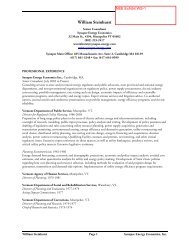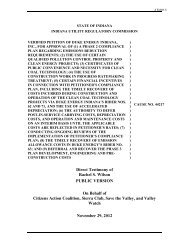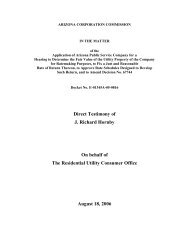Best Practices in Energy Efficiency Program Screening - Synapse ...
Best Practices in Energy Efficiency Program Screening - Synapse ...
Best Practices in Energy Efficiency Program Screening - Synapse ...
You also want an ePaper? Increase the reach of your titles
YUMPU automatically turns print PDFs into web optimized ePapers that Google loves.
TRC test or the Societal Cost test, and that the entire portfolio of programs be screened<br />
us<strong>in</strong>g the PAC test.<br />
When energy efficiency measures that are screened <strong>in</strong> the field, they should be<br />
screened us<strong>in</strong>g the Participant’s Cost test, to provide the customer with relevant<br />
<strong>in</strong>formation regard<strong>in</strong>g which measures to adopt. The TRC test should not be used for<br />
field screen<strong>in</strong>g energy efficiency measures.<br />
Illustrative Example<br />
Figure 6.1 provides an illustration of how different methodologies and assumptions can<br />
affect the cost-effectiveness of energy efficiency programs. We return to the screen<strong>in</strong>g<br />
results for the programs that we have presented above, us<strong>in</strong>g the benefit-cost ratios of<br />
the TRC test.<br />
In Figure 6.1 the best practices case (blue bars) <strong>in</strong>cludes all the avoided costs described<br />
above <strong>in</strong> Section 3 (except for the high environmental compliance costs), the other<br />
program impacts that are used <strong>in</strong> Massachusetts as described <strong>in</strong> Section 4.2, a riskadjusted<br />
discount rate of 3.2 percent, and a study period of 30 years to capture all or<br />
most of the efficiency measure lives. In contrast, the not-best practices case (red bars)<br />
<strong>in</strong>cludes all the same assumptions except that an 8.5 percent discount rate is applied,<br />
measure lives are capped at 15 years, and all other program impacts are excluded.<br />
Figure 6.1. Cost-Effectiveness Under <strong>Best</strong> <strong>Practices</strong> and Not-<strong>Best</strong> <strong>Practices</strong><br />
Source: The 2012 energy efficiency plan for our example utility, with modified assumptions.<br />
As the figure illustrates, cost-effectiveness is reduced significantly when poor screen<strong>in</strong>g<br />
practices are applied. The low-<strong>in</strong>come programs are most affected by poor efficiency<br />
practices primarily because the OPIs are excluded. The residential new construction and<br />
retrofit programs are also heavily affected, primarily because the other fuel sav<strong>in</strong>gs are<br />
not accounted for. While this illustration may seem like an extreme example, there are<br />
states that use the TRC test without <strong>in</strong>clud<strong>in</strong>g OPIs, states that use a discount rate<br />
based on WACC, and states that limit the study period to less than 30 years.<br />
| 60 <strong>Best</strong> <strong>Practices</strong> <strong>in</strong> <strong>Energy</strong> <strong>Efficiency</strong> <strong>Program</strong> Screen<strong>in</strong>g | www.nhpci.org







